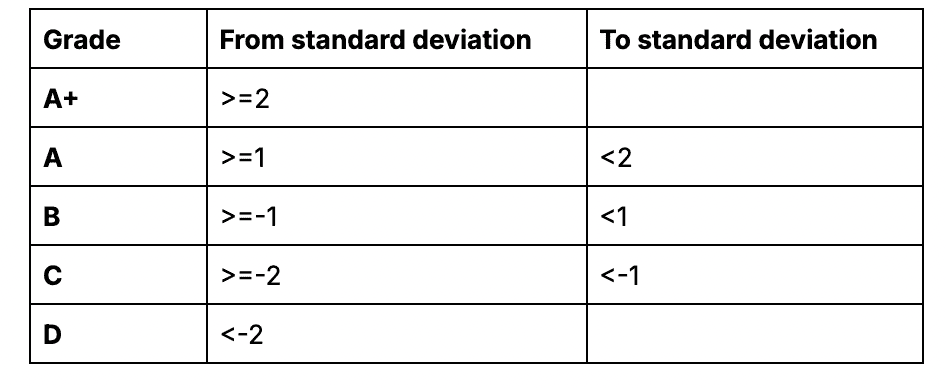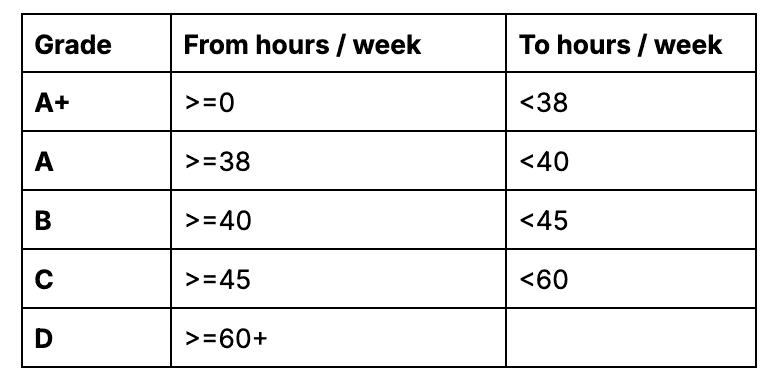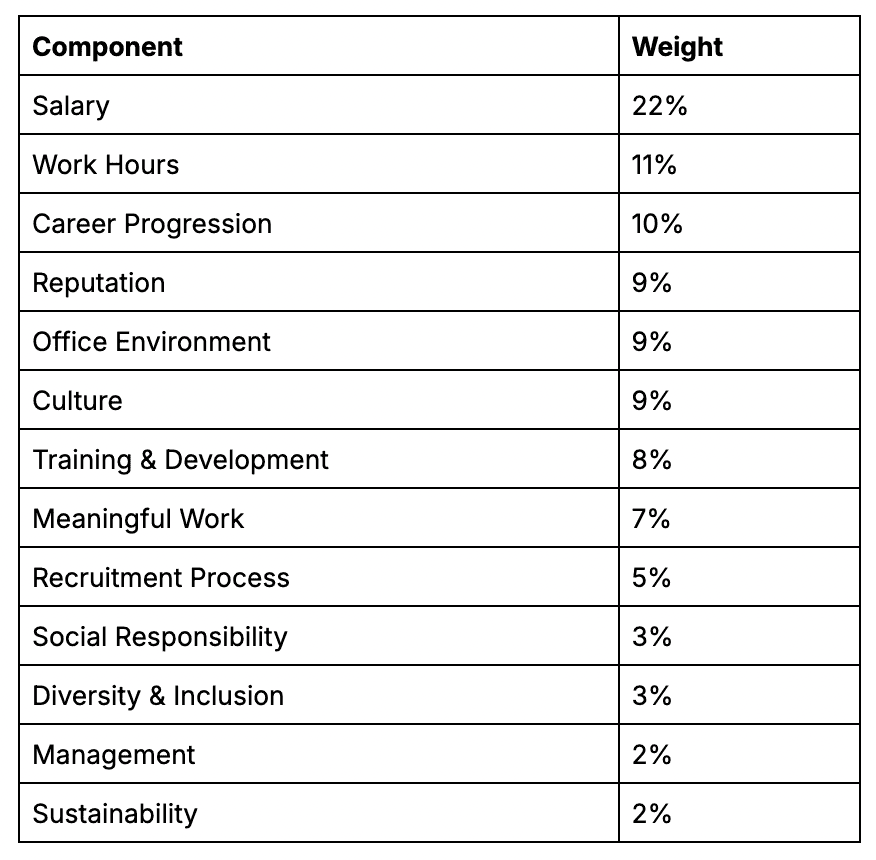
Team Prosple
Every year, Prosple publishes its Top 100 Graduate EmployersTM Guide to help students and recent graduates discover the best places to kickstart their careers.
These rankings aren’t based on guesswork or PR spin – they’re grounded in real data from student surveys, graduate reviews, application volumes, salaries, work conditions and more.
Here’s a transparent look into the methodology behind the 2026 rankings
What’s New for 2026 – TL:DR
If you’re familiar with how Prosple has built the Top 100 rankings in the past and just want a TL:DR on what’s changed, here it is:
1. New reputation ranking
We’ve renamed our ‘most-sought after’ ranking to Reputation because that’s what it truly measures: which employers students aspire to work for, whether they’ve heard of them before, and how appealing they find them.
Previously, we blended reputation with application volumes and reviews but we found that application data has limitations. For example, a prestigious employer with strict eligibility criteria might receive fewer applications but they’re still incredibly desirable, so the data can be misleading. That’s why we’ve shifted to a new survey-based approach, surveying 2,000+ current and recent graduates.
While we do publish an overall Top 100 (based on broad awareness across all career paths), we now also publish career path-specific reputation rankings. These are incredibly valuable, not just for students researching opportunities in their field but also employers targeting specific graduate talent.
2. Career paths, not industries
We moved from 18 broad industry categories to over 80 specific career paths. Why? Because students don’t search for ‘professional services industry’ jobs. Instead, they search for ‘law clerkships’ or ‘management consulting roles’. Career paths are how students think about their futures, and that’s how we now rank employers. It’s more accurate, more student-focused, and industry agnostic.
This is a fundamental shift in how to read our rankings. Instead of asking, ‘Where did we rank overall?’, the more valuable question is now, ‘Where did we rank in the career paths that matter to our hiring strategy?’
A specialist employer for example, may not appear in the overall Top 100 because they’re not widely known across all career paths, but could rank #1 in Accounting & Advisory or #3 in Civil Engineering – the rankings that actually matter for their graduate recruitment.
3. Introduction of grades
We’ve introduced an A+ to D grading system across all rankings and categories. Instead of just showing rank positions (e.g., #15), employers now receive grades that show how they compare to others within each career path.
This makes it easier for students to quickly assess employer performance – and for employers to benchmark themselves against competitors.
4. Refinements to specific rankings
We’ve also made several methodological improvements:
- Work hours are now based on actual reported hours per week, not work-life balance ratings.
- Salary data is based on the midpoint of salary ranges, instead of the top end.
- Review scores now adjust slightly for old or low-volume reviews (rather than excluding them entirely).
A deeper dive: Prosple rankings explained
Our 2026 rankings will now feature the following:
- Reputation ranking - Which employers student most aspire to work for
- Highest paying - Which employers offer the best graduate salaries
- Work hours - Which employers offers the best work-life balance based on reported work hours
- Reviews-based rankings - What it’s actually like to work at an employer based on verified graduate and intern reviews
- Overall grade - An overall score combining reputation, reviews, salary and work hours
- Criteria for inclusion - How employers qualify for the rankings
Only the reputation ranking will be featured in the 2026 Top 100 print guide. The rest will be available online. Read on for further explanation of each ranking.
Reputation Ranking
Why we rank by reputation
We’ve renamed our ‘most-sought after’ ranking to Reputation because that’s what it truly measures: which employers students aspire to work for, whether they’ve heard of them before, and how appealing they find them.
The most important thing to understand: We now calculate reputation rankings for every career path, not just an overall list. While we do publish an overall Top 100 (based on broad awareness across all career paths), the career path-specific reputation rankings are far more valuable – both for students researching opportunities in their field and for employers targeting specific graduate talent.
Previously, we blended reputation with application volumes and reviews but we found that application data has limitations. For example, a prestigious employer with strict eligibility criteria might receive fewer applications but they’re still incredibly desirable, so the data can be misleading. That’s why we’ve shifted to a new survey-based approach.
How it works
We asked over 2,000 current students and recent graduates across Australia to essentially answer two questions:
- Have you heard of this employer?
- Does this employer appeal to you?
Simple, right? But powerful. This directly measures aspiration, or in other words, which employers do students genuinely want to work for? It’s much more aligned with how students actually make decisions.
For our rankings in New Zealand and Philippines, we surveyed over 1,000 current students and recent graduates in each country.
The methodology
We randomise employer lists and use a Plackett-Luce statistical model to fairly calculate “desirability” scores. To ensure robustness, we also calculate a Total Reversed Normalised Score (TRNS), which balances out low sample sizes.
Application behaviour on Prosple is still included as an adjustment this year. We measure the number of students who start applications with each employer, adding a “popularity” factor to reflect real-world interest.
The two inputs into our Top 100 ranking, survey-based approach and application behaviour, are blended using a Bayesian weighting system, which means the more data we collect on an employer, the more weight we give to direct student preferences. The result is a balanced score that reflects both prestige and popularity.
While application data is used in the 2026 rankings, we’ll phase it out entirely in future editions. Moving forward, this is a true reputation ranking.
2. Highest paying
Money isn’t everything, but it matters. Salary is consistently one of the top factors students consider when choosing between job offers. But advertised salary ranges can be confusing – especially when they include performance bonuses or variable compensation that may not materialize.
We wanted to give students an apples-to-apples comparison of what they can realistically expect to earn as a graduate, regardless of how employers structure their compensation packages.
How we calculate it
- We take the midpoint of the advertised salary range (excluding superannuation) and convert it into standard time and currency units (Note, in previous years, we used the maximum salary but this often depended on bonuses. The midpoint reflects a more realistic measure).
- Employers are sorted from highest to lowest based on their midpoint salary
- Grades are assigned based on how many standard deviations a given employer’s salary is from the mean salary for that career path

Why this matters
Grading by standard deviation means we’re comparing employers within the same career path, not across all industries. A data science grad salary of $75K might be average while the same salary in journalism would be exceptional. Context matters, and our grading system reflects that. The result is that students can quickly see which employers in their chosen field pay significantly above average – not just which ones have the highest numbers overall.
3. Work Hours
Work-life balance means different things to different people. For some, it might mean workplace flexibility. For others, it’s simply not about working a 60-hour week. Previous rankings asked students to rate ‘work-life’ balance subjectively, which made comparisons difficult. This year, we’ve switched to something more concrete: how many hours a week do you actually work?
This gives students objective data that they can use to make informed decisions about what ‘balance’ really looks like at a different employer.
How we calculate it
For 2026, we’ve sharpened this ranking to focus on actual reported hours per week:
Students tell us how many hours they work. We calculate a time-weighted average which gives more significance to recent results Employers are then ranked from lowest to highest average hours worked, so students can see where balance is most achievable. Finally, grades are assigned based on the following criteria:

Why this matters
An A+ grade means you’re working fewer than 38 hours per week on average – a genuine work-life balance advantage. A D grade (60+ hours) doesn’t necessarily mean it’s a bad employer, but it does mean students should go in with eyes open about the time commitments. Students can then see the actual time commitment and decide if it aligns with their priorities.
4. Review-Based Rankings
Students don’t just want pay and prestige – they want to know what it’s like to work somewhere.
Reputation will get students to apply. Experience gets them to accept offers – and stay.
Students consistently tell us that they want to hear from people who’ve actually worked at an employer, not just marketing claims. That’s why we’ve built comprehensive rankings entirely based on verified graduate and intern reviews.
These rankings answer the questions that students really care about: “Will I grow here?”, “Is the culture supportive?”,
Our review-based rankings are drawn directly from verified student and graduate reviews on Prosple. Categories include:
- Career progression
- Culture
- Diversity & inclusion
- Training & development
- Social responsibility
- Management quality
- Office environment
- Recruitment process
- Sustainability
To ensure fairness, we adjust scores for:
5. Overall grade
Students don’t make decisions based on a single factor. They weight multiple considerations – salary, culture, work-life balance, career growth, and reputation. But comparing employers across all these dimensions can be overwhelming.
That’s why we have introduced an overall grade for each employer within a career path. Think of it as a shortcut to the complete value proposition – a single letter grade that synthesizes performance across the factors that matter most to students.
How we calculate it
The overall grade is made up of a number of career path specific scores, all of which are weighted differently according to what students tell us matters when choosing an employer.

The above weights were calculated by analyzing multiple student sentiment data sets Prosple has access to.
What this means
An employer might rank #1 for reputation but receive a B overall grade if their salary is below average or work hours are excessive. Conversely, a lesser-known employer could earn an A+ overall grade thanks to exceptional culture, training and work-life balance scores.
The overall grade helps to provide a more complete picture – not just the brand name.
6. Criteria for inclusion
To ensure our rankings reflect real graduate employer opportunities, not just any company with a website, we’ve set clear inclusion criteria.
The requirements:
For an employer to feature in a career path ranking within a country, they must
- Have had a dedicated graduate job or internship published on Prosple that fits into that career path
- Received at least one apply now click between 1 September 2023 and 31 August 2025
- Be hiring within that country
These criteria ensure students not only see employers who are actively hiring graduates in their field. No outdated programs, no inactive employers, no misleading listings -just real opportunities they can actually apply for.
Final Note
Our goal is simple: to give students transparent, reliable, and fair information when choosing where to apply. By combining student voice, real behaviour data, pay, and reviews, the Prosple 2026 Top 100 Graduate EmployersTM allows students to find the employers and opportunities that best fit what matters to them—be that reputation, pay, graduate satisfaction, or a combination of all.
Remember: The overall Top 100 is just the starting point. The real value lies in the career path-specific rankings, review-based grades, and comprehensive data that help students find their best fit—and help employers showcase their strengths where it matters most.

